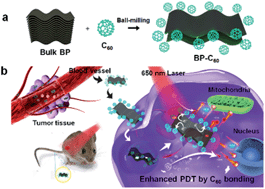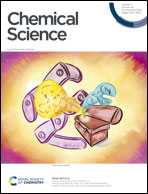Enhancing the photodynamic therapy efficacy of black phosphorus nanosheets by covalently grafting fullerene C60†
Abstract
Few-layer black phosphorus (BP) nanosheets show potential application in biomedicine such as photodynamic therapy (PDT), and are therefore commonly used in anticancer therapy and nanomedicine due to being relatively less invasive. However, they suffer from low ambient stability and poor therapeutic efficacy. Herein, C60 was covalently grafted onto the edges of BP nanosheets, and the resultant BP-C60 hybrid was applied as a novel endocytosing photosensitizer, resulting in not only significantly enhanced PDT efficacy relative to that of the pristine BP nanosheets, but also drastically improved stability in a physiological environment, as confirmed by both in vitro and in vivo studies. Such improved stability was due to shielding effect of the stable hydrophobic C60 molecules. The enhanced PDT efficacy is interpreted from the photoinduced electron transfer from BP to C60, leading to the promoted generation of ˙OH radicals, acting as a reactive oxygen species (ROS) that is effective in killing tumor cells. Furthermore, the BP-C60 hybrid exhibited low systemic toxicity in the major organs of mice. The BP-C60 hybrid represents the first BP-fullerene hybrid nanomaterial fulfilling promoted ROS generation and consequently enhanced PDT efficacy.

- This article is part of the themed collection: 2020 Chemical Science HOT Article Collection


 Please wait while we load your content...
Please wait while we load your content...